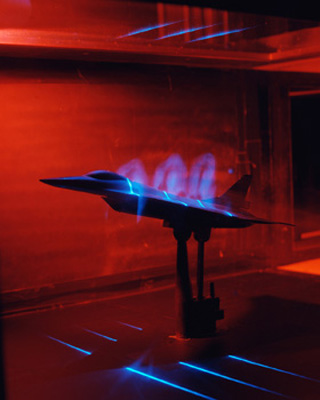
F-16 Scamp model being tested in NASA's Basic Aerodynamics Research Tunnel. Photo shows a basic flow visualization test using smoke and a laser light sheet to illuminate the smoke. (Photo courtesy of NASA.)
Instructor(s)
Prof. Anette Hosoi
MIT Course Number
2.26
As Taught In
Spring 2004
Level
Graduate
Course Description
Course Features
Course Description
2.26 is a 6-unit Honors-level subject serving as the Mechanical Engineering department's sole course in compressible fluid dynamics. The prerequisites for this course are undergraduate courses in thermodynamics, fluid dynamics, and heat transfer.
The goal of this course is to lay out the fundamental concepts and results for the compressible flow of gases. Topics to be covered include: appropriate conservation laws; propagation of disturbances; isentropic flows; normal shock wave relations, oblique shock waves, weak and strong shocks, and shock wave structure; compressible flows in ducts with area changes, friction, or heat addition; heat transfer to high speed flows; unsteady compressible flows, Riemann invariants, and piston and shock tube problems; steady 2D supersonic flow, Prandtl-Meyer function; and self-similar compressible flows. The emphasis will be on physical understanding of the phenomena and basic analytical techniques.
Other Versions
Other OCW Versions
OCW has published multiple versions of this subject. ![]()


